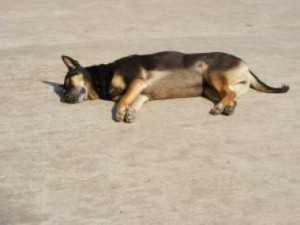 Many protection dog owners are not aware of the fact that dogs also get seizures. Of course, it is not the most pleasant situation to think about, but understanding seizures in dogs will allow you to help your four legged companion in the time of need. If a dog is having seizures, then it might be a sign of a problem with its nervous system.
Many protection dog owners are not aware of the fact that dogs also get seizures. Of course, it is not the most pleasant situation to think about, but understanding seizures in dogs will allow you to help your four legged companion in the time of need. If a dog is having seizures, then it might be a sign of a problem with its nervous system.
Read on to understand why these convulsions take place and how can they be treated.
Signs of a Seizure in a Protective Dog
Seizures or convulsions occur in dogs that are suffering from a neurological problem. These fits can occur in any dog, regardless of their breed. Even if your dog belongs to a small breed or is a strong protection dog, it can have fits.
If you are aware of the symptoms of a neurological disorder or seizures, it will become easier for you to get help in time. Below are a few signs that indicate that your personal protection dog is having fits or has a neurological condition:
• The entire muscles of the body contract
• Lack of focus and concentration
• Non-responsiveness or hallucinations
• Loss of consciousness
• Uncontrolled urination, salivation, and defecation
• Changes in behavior
• Non-recognition of the owner or other family members
• Running in circles
The Three Phases of a Seizure
Seizures occur in three steps. By getting to know about these steps, you will be able to provide proper care to your dog and may even save its precious life. Below is a brief description of these three steps and how each affects your dog.
Pre-Ictal Phase
The first stage of a seizure is when the dog starts to feel the neurological symptoms taking a toll in it. The dog might act nervous, restless, conscious, and will seek out for the owner. Because this is a stressful feeling, the dog might also hide somewhere. It might be whining or shaking its head in discomfort. In the pre-ictal stage, the dog might also salivate, urinate, or defecate in the house.
Ictal Phase
The actual seizure is also known as the ictal phase. When the dog is having a fit, all of the muscles of its body will contract and it will be in a paralyzed state. However, its body will be shaking and its head will be backwards. The dog having a seizure will urinate, defecate, and salivate. This phase lasts for a few seconds to almost five minutes. If the seizure lasts longer than five minutes, then the dog might be in prolonged seizure.
Post-Ictal Phase
When the dog enters the post-ictal phase, it begins to salivate, and show signs of confusion, disorientation, and restlessness. Sometimes dogs also suffer from temporary blindness after a seizure.
Getting Your Guard Dog Checked
Once the seizure is over, it is time to take a deep breath and calm your nerves. Then, take your dog to the vet and get it checked. A vet will perform a complete physical exam of the dog and will ask you about the history of its health. The vets would want to know if the dog suffered a head injury in the past or came in contact with poisonous materials.
The vet will also take a sample of your dog’s blood for testing purposes. Sometimes an ECG is also performed in order to examine the condition of the heart. An ECG helps rule out the possibility of liver, kidneys, and heart damage. If your dog hasn’t taken a heartworm preventative, then the vet will also perform a heartworm test.
If the test results do not show any signs of toxicity or head trauma, the vet will perform more diagnostic tests. If the seizures are occasional, the vet will not be too concerned. However, if they occur constantly in an elderly dog, the vet will perform a spinal fluid tap, MRI, and fluid analysis.
Preventative Measures
There are a few things that you can do to try and prevent seizures in your personal protection dog. Depending on the intensity and amount of seizures, the vet will suggest anticonvulsant therapy for your dog. However, if the seizures are mild and occur only once in a while, the vet will only keep a record of it without suggesting any therapy.
If the seizures occur every 45-60 days, your dog will simply be put on anticonvulsant medication which will be given to the dog every 12 to 24 hours every day.
Seeing your dog having fits is not a sight that a pet owner wants to see, but these seizures are not painful for the dog. If the seizures are very occasional, there is no need to worry. However, if they occur often, get help from a vet as soon as possible.
